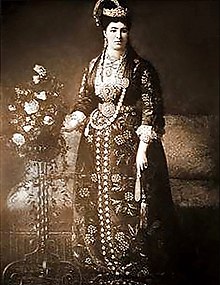| Jeshm Afet Hanim | |||||
|---|---|---|---|---|---|
| Third Princess | |||||
 | |||||
| Princess consort of Egypt | |||||
| Tenure | 1863 – 26 June 1879 | ||||
| Born | 1830 | ||||
| Died | 11 November 1907(1907-11-11) (aged 76–77) Khedivate of Egypt | ||||
| Burial | Al-Rifa'i Mosque | ||||
| Spouse |
Isma'il Pasha of Egypt
(m. 1863; died 1895) | ||||
| Issue |
| ||||
| |||||
| House | Alawiyya (by marriage) | ||||
| Religion | Sunni Islam | ||||
Jeshm Afet Hanim (Arabic: جشم آفت هانم; Turkish: Çeşmiafet Hanım; died 11 November 1907) was the third wife of Khedive Isma'il Pasha of Egypt. She was the adoptive mother of the future Sultana of Egypt, Melek Tourhan.
Life
Jeshm Afet was originally a concubine bought to the harem of the Muhammad Ali dynasty from the Circassian slave trade. She married Isma'il Pasha as his third wife just after his accession to the throne in 1863. She was given the title of "Third Princess", a position at which she remained throughout his entire reign, until his deposition in 1879. In Egypt she was known as Kutschuk Hanim or Little Lady. She mostly wore traditional Ottoman garments, featuring a few western details. She was a poet. In 1869, she met with the Princess of Wales Alexandra of Denmark, when the latter visited Istanbul with her husband Prince of Wales Edward (future Edward VII).
Al-Tahtawi's book on the education of women, titled al-Murshid al-Amin lil Banat wa al-Banin (the faithful guide for girls and boys) published in 1873, was commissioned by Khedive Ismail after Jeshm Afet, used her own money to establish the first general public school for girls at al-Suyufiya in 1873, the Suyufiyya Girls' School, which claimed additional fame to her. The genealogy of the dynasty revealed that Jeshm Afet had no children of her own, which might explain her interest in the education of young girls. She had adopted a daughter, Faika Hanim. She was married to Mustafa Pasha, son of "Mufettish" Isma'il Pasha Sadyk. Immediately after the downfall of her father-in-law, she was divorced by her husband.
Hasan Tourhan Pasha, a captain in the Ottoman Navy offered an adoption of his daughter Melek, in order to improve her lot in life. Melek was adopted by Jeshm Afet, during the 1870s. While they lost touch with each other following the exile of Khedive Ismail, when Melek Hanim became the second wife of Prince Husein Kamel in 1887 returning to Egypt with him, she resumed her acquaintance and a relationship with Aisha Taymur. There was no doubt that the relationship between Jeshm Afet and Taymur was shaped by their mutual interest in women's education and poetry that reflected the changing interests and concerns of some royal and upper-class women beyond mothering and feminine crafts.
Jeshm Afet was widowed at Isma'il's death in 1895. In 1897, she took an active part in the Greco-Turkish War by contributing to the donation collection efforts in Egypt.
Death
Jeshm Afet Hanim died on 11 November 1907, and was buried at the Khedival Mausoleum, Al-Rifa'i Mosque, Cairo, Egypt.
In popular culture
In the 2014 Egyptian historical drama series Saraya Abdeen, Jeshm Afet is portrayed by Egyptian actress Sawsan Arshid.
Gallery
See also
References
- ^ Tanman, M (2011). Nil kıyısından Boğaziçi'ne : Kavalalı Mehmed Ali Paşa Hanedanı'nın İstanbul'daki izleri = From the shores of the Nile to the Bosphorus : traces of Kavalalı Mehmed Ali Pasha Dynasty in İstanbul (in Turkish). İstanbul: İstanbul Araştırmaları Enstitüsu. p. 45. ISBN 978-975-9123-95-6. OCLC 811064965.
- Kal (1997). İstanbul su külliyât (in Turkish). İstanbul: İstanbul Aras̨tırmaları Merkezi. p. 98. ISBN 978-975-8215-04-1. OCLC 43430901.
- ^ Doumani 2003, p. 258.
- Cuno, Kenneth M. (April 1, 2015). Modernizing Marriage: Family, Ideology, and Law in Nineteenth- and Early Twentieth-Century Egypt. Syracuse University Press. p. 33. ISBN 978-0-815-65316-5.
- ^ Doumani 2003, p. 270.
- Chennells, E. (1893). Recollections of an Egyptian Princess. William Blackwood. p. 7.
- ^ Öztürk, D. (2020). "Remembering" Egypt's Ottoman Past: Ottoman Consciousness in Egypt, 1841-1914. Ohio State University. pp. 128–29.
- Cherry, Debrah; Halland, Janice (2006). Local/global: Women Artists in the Nineteenth Century. Ashgate Publishing, Ltd. p. 79. ISBN 978-0-754-63197-2.
- Grey, Maria Georgina Shirreff (1870). Journal of a Visit to Egypt, Constantinople, the Crimea, Greece, &c:In the Suite of the Prince and Princess of Wales. Harper. pp. 32–33.
- ^ Mervat F. Hatem (12 April 2011). Literature, Gender, and Nation-Building in Nineteenth-Century Egypt: The Life and Works of 'A'isha Taymur. Palgrave Macmillan. pp. 2, 198. ISBN 978-0-230-11860-7.
- Hassan, Hassan (2000). In the House of Muhammad Ali: A Family Album, 1805–1952. American University in Cairo Press. ISBN 978-977-424-554-1. OCLC 45016821.
- Masson, D.; Grove, G.; Morley, J.; Morris, M. (1879). Macmillan's Magazine. Macmillan and Company. p. 483.
- "His Highness Hidiv Ismail Paşa Hidiv of Misir (Egypt), Sudan and Taşoz". Retrieved 7 December 2020.
- "Royal Tombs, Rifa'i Mosque, Cairo, Egypt". 22 May 2010. Retrieved 7 December 2020.
- "Saraya Abdeen (TV Series 2014– )". IMDb. Retrieved 2023-12-16.
Source
- Doumani, Beshara (2003). Family History in the Middle East: Household, Property, and Gender. SUNY Press. ISBN 978-0-791-48707-5.


